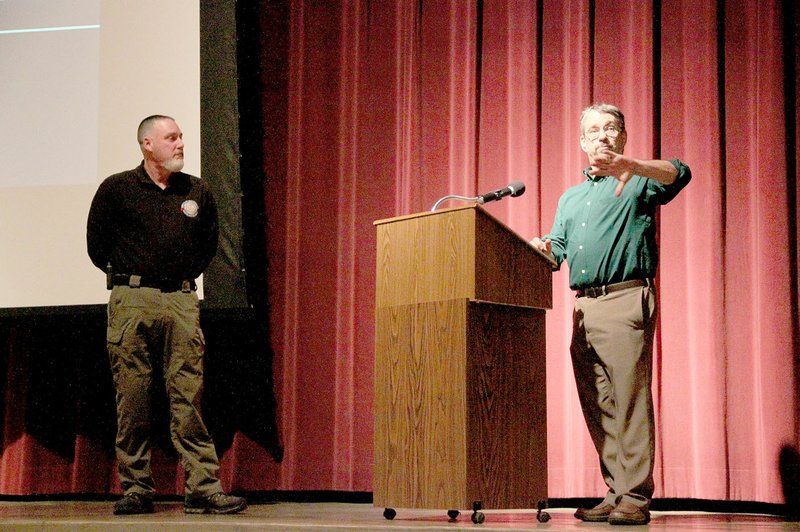LINCOLN -- An evening filled with tornado watches and tornado warnings was the perfect segue for a Tornado Town Hall meeting held the next day to provide severe weather information to the Lincoln community.
John Luther, director of Washington County Emergency Management, and Steve Piltz, meteorologist in charge with National Weather Service in Tulsa, opened the Town Hall meeting by answering questions and telling a little bit about what they do.
CodeRED
To sign up, go to the city or county website and click on link for CodeRED.
Farmington
Prairie Grove
Lincoln
Washington County
"After last night, I think it's very timely we're here to discuss tornadoes," Luther told about 50-60 people gathered in Lincoln Middle School auditorium.
Severe weather came through Oklahoma and Arkansas on March 6, with the NWS confirming tornadoes touched down in at least three areas.
The forum was sponsored by Lincoln Middle School EAST Lab and a group of sixth-grade girls in the class.
Luther said the emergency management's responsibility is to have a plan for inclement weather and to help put that plan in action when necessary. The county works in partnership with the National Weather Service in Tulsa.
Both men encouraged residents to sign up for the CodeRED emergency notification system. Lincoln, Prairie Grove and Farmington all use CodeRED as well as the county for people in unincorporated areas. The system sends out alerts to home phones and cell phones of people who have registered for the free service.
Prairie Grove police Cpl. Brian Key said Lincoln's tornado siren doesn't necessarily go off if Lincoln is in the box for a tornado warning. Officers keep an eye on the radar and what's happening, Key said. The siren sounds for three minutes and then a decision is made whether to sound the siren another time.
"We don't want to set it off and cry wolf too often," Key said. "If we set it off, you can bet something's coming toward Lincoln."
In addition to the siren, officers drive around town with police sirens blaring as well as using a PA system to make sure everyone knows about the potential for dangerous weather.
Luther said people should be aware of the weather around them and pay attention to forecasts.
One person asked Piltz how the National Weather Service decides to issue a tornado warning if a tornado has not been spotted in the air or on the ground.
Piltz said data is computer generated but a human element is involved also. One or two meterologists watch the data and compare information before making a decision on whether rotation on the radar has increased enough to issue a tornado warning.
Using data from the recent March 6 storm, Piltz said one meterologist responded, "I wouldn't let this (rotation) go over my house without a phone call."
So the decision was made to issue a tornado warning for Washington County, with the storm moving east from Lincoln toward Fayetteville.
"It's a human call and it may not turn into a tornado," Piltz said.
Luther added, "That's the balance. When a warning goes off, there are people in Tulsa who are worried about you."
Using the same storm as an example, Piltz said the rotation in western Washington County did not turn into a tornado but meterologists saw a similar rotation near Greasy, Okla. The discussion was whether to issue a tornado warning since one did not form in Washington County. The National Weather Service decided to sound a warning and in fact an EF-1 tornado struck the small town, damaged about 12 homes and destroyed the local community center.
Piltz said a tornado watch means overall conditions are there for a tornado to form. A tornado warning means a tornado is occurring or conditions exist that it is likely a tornado will form.
The Town Hall included a presentation by the EAST Lab team that showed tornadoes are rated based on wind speed and range in strength from the lowest, an F0, to F5, the most dangerous. An F1 or F2 tornado, for example, has wind speeds that go from 73 mph to 157 mph. Wind speeds of an F5 tornado can top 300 mph.
Washington County has had about 20 tornadoes from 1950 to 2015, but no F4 or F5 tornadoes.
The Town Hall meeting also included a video produced by Jana Claybrook about the F3 tornado that hit Cincinnati at 6 a.m., Dec. 31, 2010. The tornado was 21 miles long and 500 feet wide and devastated the small community. Claybrook's video showed the destruction caused by the tornado that stuck without warning.
Claybrook lived about two miles northeast of the tornado's path. She said her husband was milking cows at 4 a.m. and came in and told her to put on her shoes and get ready because a storm was coming.
"He never says that."
CodeRED was not available in 2010 but Claybrook said she is glad to have the alert system now.
General News on 03/15/2017
